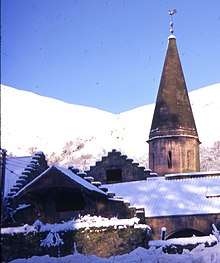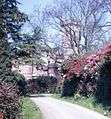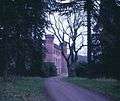Harviestoun
Harviestoun is an estate in Tillicoultry parish, Clackmannanshire, central Scotland. It lies at the base of the Ochil Hills, around 1.5 kilometres (0.93 mi) east of Tillicoultry and 2 kilometres (1.2 mi) west of Dollar.

History
The Harviestoun estate and its original manor house was bought in around 1780 by Edinburgh lawyer John Tait. It was during a visit to Harviestoun in the summer of 1787 that Robert Burns met Charlotte Hamilton, who inspired his poem "Fairest Maid on Devon Banks". A commemorative cairn on the main road (now the A91) marks his visit. Harviestoun Castle was built in 1804 by Craufurd Tait (1765–1832) after inheriting the estate from his father in 1800. In 1805 Tait purchased Dollar Glen, including the 15th-century Castle Campbell from the Duke of Argyll.[1] He also constructed a new home farm, coach house and walled garden and moved the main road to Dollar half a mile to the south. Craufurd Tait died in 1832 and was buried in the private family graveyard, now known as Tait's Tomb. The main road takes a wide sweep to its north as a linear route would have obliterated the tomb, which lies midway between Dollar and Tillicoultry. Craufurd's youngest son Archibald Tait (1811–1882), who was later Archbishop of Canterbury, spent much of his boyhood at Harviestoun.[2]
Craufurd's son, Archibald Campbell Tait, who spent his early years at Harviestoun, later became Archbishop of Canterbury.
Businessman and former Lord Provost of Glasgow Sir Andrew Orr (1802–1874) bought the estate in 1859. He added a new tower and porch to the castle, in pink sandstone, and formed two approaches, one leading from Tillicoultry, the other from the East Lodge, situated about one mile west of Dollar.
20th century
After fire destroyed much of the Playfair building at nearby Dollar Academy in 1961, Harviestoun Castle acted briefly as a satellite for Prep (Primary) School classes, as secondary school pupils occupied the Preparatory School building. Much of the castle was 'out of bounds' due to structural problems (possibly dry rot), but was a popular home for pupils of that era, according to accounts in school magazines. The grounds featured extensive gardens framed by two giant sequoia trees on the south lawn, and extensive plantings of rhododendron and bamboo. The castle was demolished in 1970.[3] For a period in the 1970s a small private coal mine operated on the estate.
Gallery
 Harviestoun Castle from East c.1968
Harviestoun Castle from East c.1968 Harviestoun Castle from West c.1968
Harviestoun Castle from West c.1968
References
- Tabraham 2008, p. 30.
- Fremantle, William Henry. "Tait, Archibald Campbell". Dictionary of National Biography, 1885-1900. 55. pp. 292–299.
- "Harviestoun Castle". Royal Commission on the Ancient and Historical Monuments of Scotland. Retrieved 10 May 2014.
- Tabraham, Chris (2008). Castle Campbell. Historic Scotland. ISBN 978 1 904966 91 3.CS1 maint: ref=harv (link)
External links
- Harviestoun Castle, Tillicoultry.org.uk